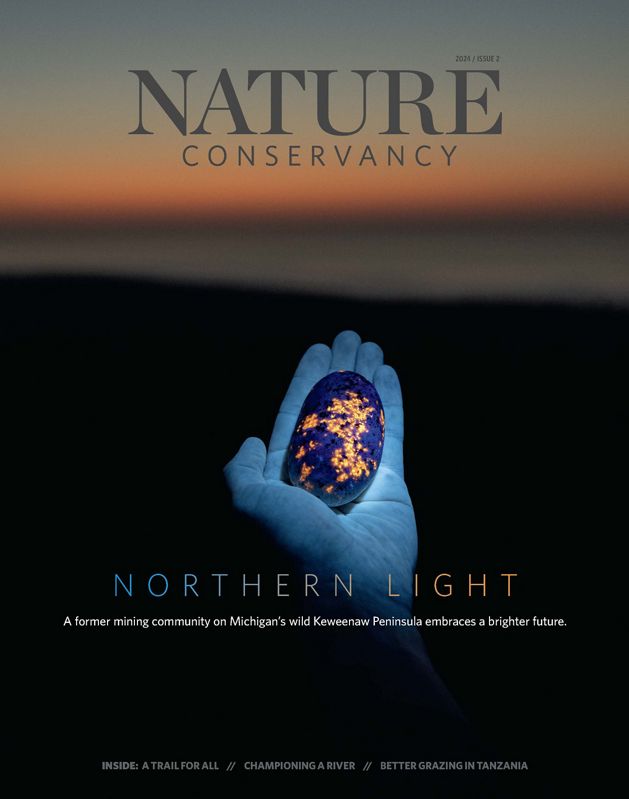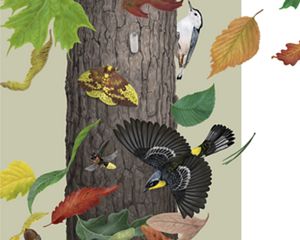
Water Color Norfolk’s chalk streams, like the River Wensum, are renowned for the clear blue water and the water lilies that bloom at their surface. © Emli Bendixen
Standing in the middle of a grassy, scrubby field, a re-meandered stream settling into the landscape, Glenn Anderson looks a little amazed, as though he can’t quite believe it. Just two fields of sugar beet to go, and, with the exception of some regeneratively grown blackcurrants, 2,000 acres of what once was arable land in Norfolk, England, will no longer be farmed traditionally. “We’ve taken the whole farm out,” he says, “which has been quite a big, scary step.”
Anderson is a fifth-generation farmer, so he does not exaggerate when he says this. He is the project lead for a nature recovery initiative called the Wendling Beck Environment Project. Started in 2020, the project has brought together Anderson and three neighboring farmers who are completely rethinking how to use their land. Through the project—a partnership among the farmers, The Nature Conservancy, Norfolk County Council, Norfolk Rivers Trust and others—they are exploring ways to make a living off their properties with a focus on restoring biodiversity. Instead of neat and tidy rows of crops like wheat and barley, now meadows, wetlands and unruly hedges are all you can see for miles around. Already, they are seeing the return of birds, insects and other fauna.
Projects like Wendling Beck address a challenge that is fast becoming a reality for business owners and residents across the county: a diminishing supply of water.
Nestled in an eastern corner of England, Norfolk is a low-lying county much loved for its vast coastline, its big skies and both its natural and human-made beauty. It’s home to 25 “chalk streams”—a globally rare and biodiverse habitat type. However, as the weather becomes increasingly erratic amid a changing climate, Norfolk has become prone to both flooding and drought. Traditional farming methods have polluted bodies of water and put pressure on the limited water supply, and a steadily growing population has added to the strain.
“There is no spare water in Norfolk,” says Daniel Johns, managing director at Water Resources East, an independent membership organization tasked with safeguarding a sustainable supply of water for eastern England. “Too much water is being taken out of the environment.” This has meant restrictions on housing, farming and business—a clear reflection of how a lack of water has become a constraint on economic development in the county.
To address this challenge, the Norfolk Water Strategy Programme (NWSP) was launched in 2021, bringing together regional water utility company Anglian Water, Norfolk County Council, Water Resources East and The Nature Conservancy to find ways to reclaim and restore Norfolk’s waterways. Their most ambitious plan so far, perhaps, is the creation of the Norfolk Water Fund.
This prototype fund is investing philanthropic money to unite downstream water users and upstream communities around a common conservation goal. Investment from public, private and philanthropic sources will go toward efforts like river restoration, regenerative agricultural practices and restoring riparian buffers to boost local water quality and quantity. This collective investing addresses the hard truth that without access to good-quality water, the ability to run any business—from a coffee shop to a farm—becomes next to impossible.
“We can’t grow our economy, and we can’t support a healthy environment for people to work, play and live, unless we really tackle water,” says Wendy Brooks, the head of environment at the Norfolk County Council.
Wild Farms
Farmers like Rosie Begg, who grows blackcurrants, and Glenn Anderson signed on to join the Wendling Beck Environment Project in Norfolk. Since 2020, the project has taken thousands of acres out of farm production to create more natural habitats, including meadows.





Rosie Begg: Rosie Begg grows blackcurrants in Norfolk. © Emli Bendixen

Nature: A flower meadow planted in Norfolk. © Emli Bendixen

Glenn Anderson: Glenn Anderson has taken many acres out of farm production in Norfolk and now advises on projects helping others do the same. © Emli Bendixen

Wildlife: A banded demoiselle alights on the flower of a yellow water-lily in the River Wensum. © Emli Bendixen
In a lush field in the middle of Norfolk, Donna Dean is wearing some bright orange high-visibility rain gear. Dean, a river catchment and restoration team lead for a river advocacy group called The Norfolk Rivers Trust, is giving a progress report to a landowner. They are “re-meandering” (or “re-wiggling” as some put it) the Yare, a chalk stream that runs through his property. It’s one of the Norfolk Water Fund’s pilot projects, and it aims to restore meanders and pauses to the river’s flow, allowing the Yare to once again support biodiversity as a natural chalk stream would.
The rain falls quite determinedly as Dean walks the farmer through their work. It began in 2023 and has, admittedly, been slowed down both by the weather and by some necessary water vole mitigation. (The endangered water vole is a protected species in the U.K.) “The river will be bunded here, so that will create a small barrier,” Dean says, pointing to a newly dug channel that will allow the stream to reclaim its original path. “There are some pools and scrape ponds in the middle, and there’ll be a little sub-channel that snakes through.”
Dean used to be a science teacher, and there is a gentle way about her delivery. She is also an avid birder. She tells the farmer she thinks he now has some oystercatchers nesting on his land. She has also seen four little egrets, plus a sandpiper and a massive brood of ducklings that, she says confidently, “were not mallards.” The farmer agrees. He has seen them, too.
The Yare is one of about 25 chalk streams that run through Norfolk. A gift from the Cretaceous Period, the chalk in the underlying aquifer is an alchemist, clarifying and purifying the water, cooling and enriching it with minerals. When chalk rivers are treated correctly, they don’t flood, because their sponge-like aquifers—an extraordinary network of underground chalk tributaries and tunnels—hold the water and regulate its release. They attract all manner of biodiversity—water voles, mayflies, trout—and the flora is astonishing.
Of the mere 250-odd chalk streams in the world, more than three-quarters are located in England. Many are under threat. Far too often, they have been straightened and become, as one farmer described them, “glorified drains.” The biodiversity within them has been ravaged by pollution.
When a chalk stream is straightened and its soil has been depleted, water has nothing to hold it and prevent it from flooding an area before washing away into other rivers and out into the sea. Even the etymology will tell you how these chalk streams are meant to be. Wensum, the name of one chalk stream in Norfolk, is derived from the old English adjective “wandsum,” or “wendsum,” which means “wandering.”
What Dean and her team are trying to do in this misty, rain-soaked field in Norfolk is reclaim the sponge function of the soil and re-wander the stream, restoring it to its original path. It’s the type of work they hope to replicate for several chalk streams in the county.
“If we can fund lots of these kinds of projects across the county, they will make our landscape more resilient both to drought and to floods,” says Hannah Gray, Water Resources East Programme manager for nature-based solutions. “Instead of relying on concrete flood defenses, or building bigger flood walls around our cities, we can have systems like this that give us these benefits, and also provide us with all the other things we want, like wildlife, nice places to walk and biodiversity restored.”
The restoration of a chalk stream is the epitome of a “nature-based solution,” a way to tap into nature’s innate ability to repair our ecosystem. “If you give nature half a chance, bring [restored habitats] and the species will come,” says David Diggens, the president of the Norfolk Rivers Trust. The resulting biodiversity means that a re-wandered chalk stream and a restored wetland will, in addition to contributing to better water management, absorb far more carbon dioxide than an open field. “Bingo!” Diggens says.
There is an urgency to this work. Robin Price is the director of quality and the environment at Anglian Water. “We are in a biodiversity crisis and a climate crisis,” he says, “and the way that climate chaos is felt and biodiversity loss is felt first is through water.” Traditionally, water companies are quick to build pipes and reservoirs and to use chemicals at water treatment plants to neutralize phosphorus and nitrogen. To Price’s mind, this won’t wash anymore. Anglian Water plans to be carbon net zero by 2030, and, Price says, “if we continue to use gray infrastructure as a way to build our way through problems, we are not going to hit our target.”
Nature-based solutions are good for the bottom line, Price says. Restored rivers hold water within their drainage basin, slowing its flow and giving the aquifers a chance to recharge because rainwater can seep back into them. The alternative—letting water barrel its way to the North Sea and cause flooding as it goes—would mean Anglian Water needs to build a desalination plant to bring it back in. “Nature-based solutions sound lovely,” Price says, “but they [also] make enormous business sense.”
Water funds as a concept have been around for decades. The Conservancy pioneered the model 25 years ago in Ecuador and since then has supported the creation of more than 50 similar programs around the world. Each one is different, but they all help water users invest in conserving the ecosystems where their water comes from as a way to address water scarcity for people and protect habitats critical for biodiversity. Today, TNC’s global Resilient Watersheds Program is dedicated to mainstreaming the adoption of these “nature-based solutions” in the water sector.
The Norfolk Water Fund is the first water fund the environmental organization has put its weight behind in Europe. In February 2024, TNC and its coalition partners in the NWSP made their business case: Every £1 invested in nature would see £6.70 in returns on investment through improved water quality and quantity, reclaimed biodiversity, increased carbon in the soil, and an uptick in employment to implement nature-based solutions, not to mention the feasibility for all businesses to be able to operate for the long term. “Through this collaboration,” says Brooks at the Norfolk County Council, “we have been able to create new evidence to demonstrate that it is cost beneficial to tackle poor water quality and poor water availability by investing in nature-based solutions.”
Planning has been meticulous. The Nature Conservancy has created “opportunity maps,” which it intends to make available to potential investors and landowners. These maps will lay out in the best available detail what kind of nature-based solution works where, says Rob Cunningham, a Norfolk native who leads the Resilient Watersheds Program for TNC in Europe.
“You’re trying to identify where in the landscape you can both hold water, because you’ve got a bit of topography and you can create a mini pond, and also where in the landscape there are opportunities for that water to infiltrate in the soil,” Cunningham says. These opportunity maps can be used alongside other data to determine what is best for wildlife. Wading birds don’t like trees, for example, because their predators hide there, so avoid planting trees on wet grasslands.
Green Countryside
In Norfolk—sometimes known as England’s “breadbasket” for its crop production—rivers like the Wensum wind through agricultural land. Several properties, including Dillington Hall Estate, are re-meandering streams, planting meadows or using conservation grazing to restore habitats and reduce nutrient runoff into Norfolk.





Conservation Grazing: Cows graze near Rushmeadows near Dereham, Norfolk. Their grazing helps maintain the right mixture of plant species. © Emli Bendixen

Chalk Stream: The River Wensum is a Norfolk-area chalk stream—a type of globally rare waterway. © Emli Bendixen

History: The Bintree Watermill stands along the River Wensum, a chalk stream that once powered it. © Emli Bendixen

Open Nature: A person walks down a public access pathway at Rushmeadows in Norfolk. © Emli Bendixen
“Increasingly, farmers across Norfolk recognize that current farming practices are untenable,” Gray says. “They see crops fail due to weather volatility. They lose their fertilizers because depleted soil cannot hold them and just one rainfall event can wash them into streams and rivers, at significant cost to both their pocketbooks and to nature.”
Agriculture is a key driver of Norfolk’s economy, so adapting to alternative ways of farming—working with nature as opposed to against it—will be considered investments worthy of the fund. “We view ourselves as an anchor funder,” says Price from Anglian Water. “The hunt is on to find additional places to invest.”
The team behind the Wendling Beck Environment Project are ground-truthing many of the fund’s principles—not just ways to increase carbon in the soil or reduce fertilizer runoff but also how to pay for this work over time and how to show it makes financial sense for farmers like Glenn Anderson. New funding policies put forward by the U.K. government in the last two years are part of this effort.
One policy, Biodiversity Net Gain, focuses on all new housing and building development. As of February 2024, every developer in the U.K. must ensure that they improve the biodiversity of the landscape where they are building by an additional 10%. If this is not possible, they can buy credits at a nearby biodiversity site. The second mechanism, Nutrient Neutrality, is directed at housing developers. They are obligated to mitigate the wastewater—containing phosphorus and nitrogen—emanating from these new sites. If this is not possible on-site, they must buy credits within the same catchment, usually in the form of wetlands or buffer strips along a river’s bank. Nature restoration projects like Wendling Beck would supply credits for both programs, offering a new funding stream to landholders.
“We set out on this path to build both financial and environmental resilience,” Anderson says. “The last few years have been about the theory of it.” Now the results are starting to roll in and have a wider impact.
Anderson has become an ambassador of sorts, offering tours of Wendling Beck to interested parties—local authorities, environmentalists, farmers, policymakers and big business—as well as starting a consultancy with fellow Wendling Beck farmer Alex Begg. Currently through their consultancy, Anderson and Begg are advising on projects that cover over half a million acres in East England, many of which could be considered for funding through the Norfolk Water Fund.
Today the Norfolk Water Fund has seven pilot projects across the county ready for an investment of £1.5 million, with a plan to scale up to projects covering £30 million in investment over the next five years.
“We are in the foothills of this,” says Water Resources East’s Daniel Johns. “There’s a lot left to prove, but the interest is there, the impetus is there, and the right people are in place to put forward the solutions.”
Back at Wendling Beck, Glenn Anderson is behind the steering wheel of the farm Land Rover and is taking a small group on a tour of the land so they can see firsthand what these nature-based solutions look like. How does he feel to have moved completely away from arable farming? “It feels good,” he says. “I’ve overcome the mental hurdle of not seeing lots of neat, tidy crops.” He chuckles.
“I used to be Mr. Neat and Tidy Farmer, and I couldn’t enjoy the aesthetic of a big shaggy hedge. Now, when I see a hedge that has been flailed in August, it makes me cringe. My esthetic perception of the landscape has changed as I’ve become more educated on what’s good for nature.”
About the Creators
Lucy Carrigan is a writer based in London who focuses on climate and migration.
Emli Bendixen is a South Korean-Danish photographer based in England, where she primarily photographs people and food in natural environments.

Magazine Stories in Your Inbox
Sign up for the Nature News email and receive conservation stories each month.







